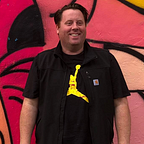My Urban Art Project in Troy, N.Y.
“To me, restoring the facade was never a construction project. I always viewed it was as an art project. Someone who I respect that is very successful in real estate told me not to fall in love with a building. The problem was it was love at first sight.” -Tom Nardacci
In 2022, I capped off a huge accomplishment — finishing the facade of Troy Innovation Garage. This project was 6 years in the making. A variety of challenges and other priorities let time pass, including a focus on the interior spaces and some unseen structural work. Primarily though we took our time with the exterior project — a meticulous effort to try to stay true to the history of the design and be inspired along the way. The front of this building is so unique and I wanted to really put it all back together and add to it as perfectly as possible.
Built in 1872, 10 years after Troy’s Great Fire destroyed most of the downtown area, the two-story 22–24 4th Street in the downtown of one of Upstate New York’s most famed Hudson River cities, initially stored and repaired horse drawn carriages and equipment. From 1905–1920 the Troy Automobile Exchange sold custom built Pierce Arrow Autos to wealthy Trojans and people from all around the Capital Region at the location. These businesses coincided with a time of great wealth in Troy brought by the success of the Erie Canal, Railroads and textile and steel manufacturing. The reason HBO has chosen to film The Gilded Age here over the past few seasons.
However, the Art Deco inspired facade seen today, comprised of glass, metal and stone, was added during an extensive renovation in the 1920s. The upstairs was converted into a dance hall call The Domino Ballroom. Massive steel I-beams were installed to eliminate columns inside to create the dance floor. And outside, the brick facade was totally removed and replaced with glass, copper and marble.
When I purchased the building in 2016, it was in a state of serious disrepair. The facade was falling apart and most of the interior had been vacant for 30 years. The 100 year old plate glass windows had not been maintained or restored in many decades. And layers of paint and ill fitting cob job repairs were made to the exterior and roof.
The first floor storefront needed to be totally replaced and new steel columns were added to support the existing foundation and structure, and to accommodate support for a newly designed and manufactured steel awning.
During renovation of the first floor storefront, the decision was made to use new copper as well as bring the 100 year old copper, that was clearly such an important element to the exterior, back to life. This involved detailed paint stripping that took several months to complete. And we luckily found a father-son coppersmith team (3rd & 4th generation) to help us reshape the storefront.
The new steel canopy was designed, fabricated locally and installed, a major investment to help the building stand out on a block that needed renewed significance. And, the steel fits because it is a material that played an important role in the 1920s renovation.
We also salvaged and restored the etched transom glass, utilizing pieces left on the top floor to create a complete front on the first floor.
Copper looks beautiful after you remove 50 years of paint and grime. But instead of coating it with a preservative and keeping the bright shine, we also decided that the right fit is ultimately what was there historically, the green-blue patina that comes with aging. And that palette fits with the veined marble, and the new awning design.
To expedite the patina process we used a mix of white vinegar & salt sprayed on, which accelerated the process. It was a local high school art teacher who told me this was the best way to transform the dulling copper. The simple solution immediately brought out a beautiful green-blue color.
The final touch for the facade was the design and installation of the signage package, which was finally completed at the end of 2022.
The end result came from the work of many talented people who helped me do this piece by piece. For everyone who worked with me on this, I am truly grateful.
Final thoughts. To me, restoring the facade was never a construction project. I always viewed it was as an art project. Someone who I respect that is very successful in real estate told me not to fall in love with a building. The problem was it was love at first sight.
-30-
#dwyck
